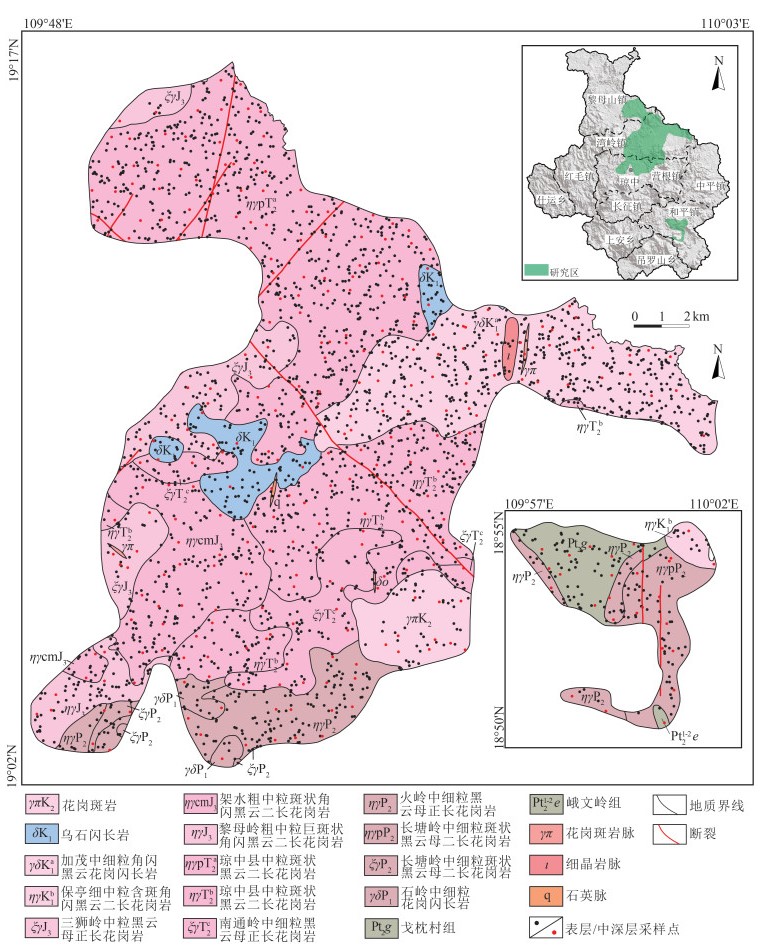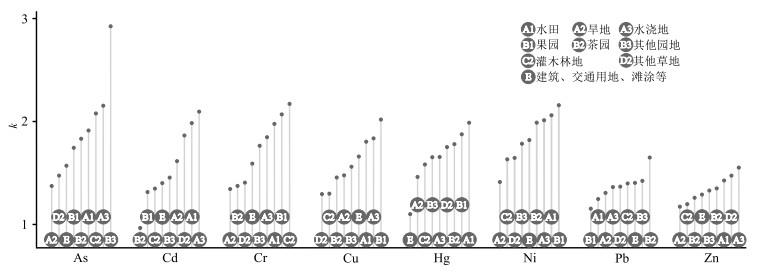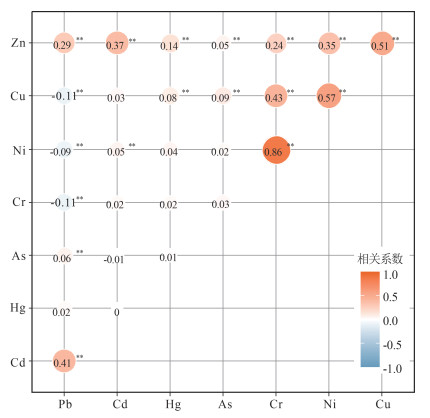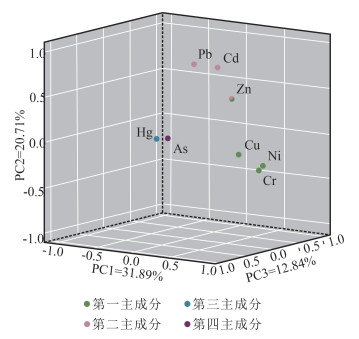Spatial distribution and ecological risk assessment of heavy metal pollution in the soil of Limu Mountain- Wanling Town, Qiongzhong, Hainan Province
-
摘要:
为了解琼中黎母山—湾岭地区土壤重金属元素分布特征及其潜在生态风险,采集了表层(0~20 cm)土壤样品2682件,对应中层(80~100 cm)及深层(180~200 cm)土壤样品各304件。分析测定Cu、Pb、Zn、Cr、Ni、Cd、As、Hg八种重金属元素。对8种重金属元素空间分布特征进行多元统计分析,并采用地累积指数法、潜在生态危害指数法对该区土壤重金属污染程度、生态风险进行评估。结果显示,表层土壤中8种重金属元素均值均高于海南岛土壤重金属背景值,表现出不同程度的积累;不同土地利用类型及种植类型对表层土壤重金属富集影响较大;垂向上,由表层至深层,土壤Pb、Zn、Cu、Cr、Ni五种重金属元素含量依次降低,但差异不大;Cd、As、Hg在垂向上表现出明显的表聚性。Pearson相关性分析与因子分析结果显示,Cu、Cr、Ni主要受地质背景影响,其余5种元素均受地质背景及人为因素影响。地累积指数结果显示,8种金属元素均值除Hg(0.08)外,均小于0,总体为无污染-轻微污染;生态风险评价显示,Cd和Hg为主要危害元素,Cd以轻微-中等危害为主,Hg以中等-强风险为主,其余元素危害指数均为轻微级,96%的土壤总体潜在生态危害指数在中等以下。
Abstract:In order to understand the spatial distribution and ecological risk assessment of heavy metal pollution in the soil of Limu Mountain-Wanling Town, Qiongzhong, 2682 topsoil samples(0~20 cm) and 304 middle-soil layer samples(80~100 cm) and subsoil samples(180~200 cm) were respectively collected to analyze for 8 heavy metal elements(Cu, Pb, Zn, Cr, Ni, Cd, As and Hg).Based on the metals' distribution, geoaccumulation index and potential ecological hazard index, multivariate statistics was conducted to evaluate the potential ecological risks.Results show that the mean values of 8 heavy metal elements in topsoils are higher than the soil background values of Hainan, showing different degree of accumulation effect.The accumulation of heavy metal in topsoils is associated with different land-use types and various planting patterns.Vertically, the contents of Pb、Zn、Cu、Cr、Ni decrease a little with depth, but contents of Cd, As and Hg are characterized by surface accumulation.Pearson correlation analysis and factor analysis suggest that Cu, Cr and Ni in the topsoils are mainly controlled by geological background, others are controlled by geological background and human activities.The mean geoaccumulation indexes of other heavy metal elements except for Hg(0.08) are less than 0.The ecological risk assessment show that Cd and Hg are the main hazard elements, Cd is mainly of slight to medium hazard, Hg is of medium to strong risk, and the hazard indexes of the other elements are all slight.The overall potential ecological hazard index of 96% of the soil is below medium hazard.
-
Keywords:
- Qiongzhong /
- soil /
- heavy metals /
- pollution /
- assessment /
- ecological risks
-
党的十九大报告指出,“要以‘一带一路’为重点,坚持引进来和走出去并重,遵循共商共建共享原则,加强创新能力开放合作,形成陆海内外联动、东西双向互济的开放格局”。在国家实施“一带一路”建设及拉美战略的契机下,提升中国在拉丁美洲地区地学领域的话语权,提高服务水平和质量,从粗放型服务向精准型服务转变,依靠科技创新解决全球重大资源环境问题和地球系统科学问题的能力,是新形势下对境外地质工作的新需求。因此,“两种资源、两个市场”、实施“走出去”是中国长期的资源战略任务,而拉丁美洲地区是中国实施“走出去”战略最重要的优选地区之一。
拉丁美洲是指从墨西哥起的西半球南部的整个地区,也就是地处北纬32°42′和南纬56°54′之间的大陆,东濒加勒比海和大西洋,与非洲大陆的最短距离约为2494.4km;西临太平洋;南隔德雷克海峡与南极洲相望;北界墨西哥与美国界河布拉沃河(即格兰德河),与美国为邻。拉丁美洲包括北美洲的墨西哥、中美洲和南美洲大陆,共有34个国家和地区,2008年人口约5.77亿,主要是印欧混血和黑白混血人种,其次为黑人、印第安人和白种人。由于本区都隶属拉丁语族,因此这些国家被称为拉丁美洲国家,这个地区被称为拉丁美洲。
早在20世纪20年代,澳大利亚学者安德鲁斯E就已指出统一的环太平洋成矿带的存在。40年代原苏联学者斯米尔诺夫C C将环太平洋成矿带划分为以铜为主的内带和以锡钨为主的外带,尔后西里托(1976)、米切尔(1976)、拉德科维奇(1983)均做出了巨大贡献,包括拉丁美洲在内的环太平洋地区的构造与矿产受到普遍重视,发表了大量的论文和专著。中国学者从西太平洋和东太平洋分析对比的角度出发做了许多研究,如张炳熹、李文达、裴荣富、戚建中、陆志刚、陶奎元等。近年来,随着境外地质矿产工作的开展,年轻一代的学者又做了许多有益的工作。特别是中国地质调查局南京地质调查中心境外地质室,他们的工作成果正陆续推向社会。《拉丁美洲地区重要矿产成矿规律研究》专辑的发表正是其集中体现。
该专辑系国内首次总结拉丁美洲地区的成矿地质条件,划分成矿区带,研究成矿系列,将对该地区进一步规划和开发起到指导作用。其主要特色在于:
(1)全面清晰地讨论了拉丁美洲地区重要成矿带的区域地质背景和成矿地质环境,通过对代表性的成矿带、成矿作用和典型矿床的研究,以点带面地阐明了拉丁美洲地区的优势矿产资源。
(2)利用大量的第一手资料,涉及原创、方法及技术,进行系统性、集成性、综合性分析整理,为拉丁美洲地区优势矿产资源成矿规律研究的真实性、准确性提供了依据,并能够使读者顺藤摸瓜,进一步查找所需资料。
(3)文章涵盖面广泛,论文编写单位以中国地质调查局南京地质调查中心为主,中国地质调查局发展研究中心、中国地质科学院地质研究所、吉林大学地球科学学院、福州大学紫金学院,以及秘鲁地质矿产冶金研究院、中国中资企业等多家单位参与;从学科领域看,从典型矿床解剖、重要成矿带成矿规律到投资环境均有涉及,并进行了国际、国内的对比研究,提升了文章的学术水平。可以服务不同层面,满足不同层次的需求。
总之,加强境外地质矿产研究工作十分重要,不仅要收集境外地质矿产资料,开展实地考察,更要加强综合研究,使境外地质矿产编图、成矿区带划分、成矿规律总结等得到深化,才能集成为有影响的大成果。《拉丁美洲地区重要矿产成矿规律研究》专辑的出版,为进一步开展境外地质成矿规律综合研究提供了有借鉴意义的工作思路、方法和实例。
在此,我热诚祝贺这一系列研究成果的取得,并向具有创新意识和国际化视野的地学人才、为境外地质矿床研究作出贡献的专家学者们表示由衷的祝贺!
 致谢: 感谢项目组所有成员的野外付出,感谢评审专家对本文提出的宝贵意见。
致谢: 感谢项目组所有成员的野外付出,感谢评审专家对本文提出的宝贵意见。 -
表 1 各指标分析方法及检出限
Table 1 The analytical methods and detection limits for various indicators
指标 分析方法 方法检出限/(mg·kg-1) Cu ICP 0.5 Pb ICP-MS 2 Zn XRF 2 Cr XRF 2 Ni ICP-MS 0.3 Cd ICP-MS 0.02 As AFS 0.2 Hg AFS 0.0005 Zn XRF 2 表 2 地累积指数污染评价标准
Table 2 Criteria for assessment of soil pollution with Igeo
地累积指数Igeo 级别 污染程度 Igeo < 0 0 无污染 0≤Igeo < 1 1 轻污染 1≤Igeo < 2 2 中污染 2≤Igeo < 3 3 中-重污染 3≤Igeo < 4 4 重污染 4≤Igeo < 5 5 重-极重污染 5≤Igeo 6 极重污染 表 3 Hakanson潜在生态危害指数评价标准
Table 3 Criteria for assessment of the potential ecological risk status with Eir & RI
生态危害 轻微 中等 强 很强 极强 Eir <40 40~80 80~160 160~320 ≥320 RI <150 150~300 300~600 600~1200 ≥1200 表 4 研究区表层土壤重金属含量特征
Table 4 Concentration distribution of heavy metals in topsoil in the study area
mg/kg 特征参数 Cu Pb Zn Cr Ni Cd As Hg 最小值 1 5.73 6.62 2.96 1.15 0.020 0.5 0.005 最大值 128 463 500 2110 488 15.2 105 0.172 均值 9.93 33.4 60.1 49.9 13.4 0.063 3.30 0.035 中位数 7.57 30.9 55.4 34.85 9.5 0.048 1.53 0.032 标准差 8.16 16.4 26.9 82.1 16.8 0.295 6.41 0.017 变异系数 0.822 0.490 0.449 1.64 1.25 4.66 1.94 0.478 海南岛土壤背景值 6.1 24.4 44.4 27.5 7.24 0.040 1.34 0.020 表 5 不同成壤母岩形成的土壤重金属平均含量
Table 5 Comparison of soil heavy metals contents by different parent rocks
mg/kg 成壤母质 样本数量 Cu Pb Zn Cr Ni Cd As Hg 黑云母花岗岩 634 11.59 29.73 62.49 64.55 17.29 0.06 2.65 0.04 闪长岩 91 21.43 26.38 78.44 106.98 25.75 0.08 6.18 0.03 花岗闪长岩 594 10.42 26.33 57.26 51.41 14.25 0.06 2.04 0.04 花岗斑岩 66 5.61 37.81 43.47 25.38 8.19 0.04 3.08 0.04 二长花岗岩 209 9.05 36.00 54.11 33.86 10.09 0.05 4.13 0.03 正长花岗岩 1018 8.57 36.99 60.01 39.67 10.48 0.07 3.60 0.03 石英闪长岩 2 5.22 47.00 34.70 40.75 11.73 0.04 1.18 0.02 云母片岩 1 3.78 24.60 48.10 3.75 1.44 0.19 10.20 0.01 斜长片麻岩 66 7.65 44.99 60.25 31.14 8.31 0.07 8.29 0.04 石英片岩 1 8.16 51.90 60.40 14.30 6.23 0.05 5.86 0.03 表 6 各重金属元素在不同深度土壤中含量相关性
Table 6 Correlation between heavy metals in topsoil and subsoil
元素 Pb-B Pb-Z 元素 Zn-B Zn-Z Pb-Z 0.78** Zn-Z 0.74** Pb-S 0.52** 0.62** Zn-S 0.63** 0.86 元素 Cd-B Cd-Z 元素 Cu-B Cu-Z Cd-Z 0.29** Cu-Z 0.81** Cd-S 0.15** 0.93** Cu-S 0.66** 0.88** 元素 Cr-B Cr-Z 元素 Ni-B Ni-Z Cr-Z 0.73** Ni-Z 0.80** Cr-S 0.72** 0.87** Ni-S 0.74** 0.90** 元素 As-B As-Z 元素 Hg-B Hg-Z As-Z 0.53** Hg-Z 0.55** As-S 0.24** 0.75** Hg-S 0.45** 0.72** 注:**表示在0.01级别相关性显著;元素符号后“-B”、“-Z”、“-S”分别代表表层、中层、深层土壤 表 7 因子分析旋转成分矩阵
Table 7 Rotated matrix of factor analysis
% 元素 成分 1 2 3 4 Ni 0.93 -0.01 -0.04 -0.04 Cr 0.87 -0.07 -0.10 -0.05 Cu 0.76 0.06 0.19 0.15 Cd 0.05 0.82 -0.06 -0.08 Pb -0.17 0.79 -0.01 0.08 Zn 0.49 0.61 0.27 0.07 Hg 0.01 -0.01 0.96 -0.02 As 0.03 0.01 -0.01 0.99 特征值 2.55 1.66 1.03 1.00 方差百分比 31.89 20.71 12.84 12.52 累积方差解释率 31.89 52.61 65.44 77.96 表 8 土壤重金属污染地累积指数分级
Table 8 The classification of heavy metals in soil based on the Igeo
重金属 指数均值 各级面积/km2 无污染 轻污染 中污染 中-重污染 重污染 重-极重污染 极重污染 Cu -0.25 160.57 87.41 26.16 3.20 0.40 0.00 0.00 Pb -0.23 194.08 80.29 3.06 0.27 0.04 0.00 0.00 Zn -0.28 184.53 89.47 3.71 0.02 0.00 0.00 0.00 Cr -0.29 165.71 78.08 27.28 4.57 1.38 0.49 0.21 Ni -0.18 158.19 81.15 31.70 5.03 1.43 0.20 0.03 Cd -0.26 176.85 87.56 12.74 0.54 0.02 0.00 0.02 As -0.08 180.65 50.77 22.75 12.93 7.95 2.21 0.47 Hg 0.08 123.08 140.37 13.18 1.11 0.00 0.00 0.00 表 9 土壤重金属的潜在生态危害指数统计
Table 9 Potential ecological risk coefficient for every heavy metal in soil
危害指数 重金属 分布范围 各级面积/km2 最小值 最大值 轻微 中 强 很强 极强 Cu 0.82 104.92 276.09 1.37 0.27 0 0 Pb 1.18 95.03 277.69 0.02 0.02 0 0 Zn 0.15 11.25 277.73 0 0 0 0 Ei Cr 0.22 153.34 276.83 0.58 0.32 0 0 Ni 0.79 337.02 274.44 3.05 0.15 0.06 0.03 Cd 14.63 11400.00 156.71 99.07 20.73 1.14 0.08 As 3.73 783.58 243.43 18.21 10.06 4.5 1.53 Hg 10.40 344.00 33.78 171.88 65.18 6.79 0.11 RI 36.06 11634.76 142.19 123.2 11.56 0.77 0.02 -
Ali L, Rashid A, Khattak S A, et al. Geochemical control of potential toxic elements(PTEs), associated risk exposure and source apportionment of agricultural soil in Southern Chitral, Pakistan[J]. Microchemical Journal, 2019, 147: 516-523. doi: 10.1016/j.microc.2019.03.034
Timofeev I, Kosheleva N, Kasimov N. Health risk assessment based on the contents of potentially toxic elements in urban soils of Darkhan, Mongolia[J]. Journal of Environmental Management, 2019, 242: 279-289. http://www.ncbi.nlm.nih.gov/pubmed/31054392
Cao S, Duan X, Zhao X, et al. Health risks from the exposure of children to As, Se, Pb and other heavy metals near the largest coking plant in China[J]. Science of the Total Environment, 2013, 472C: 1001-1009. http://www.sciencedirect.com/science/article/pii/S0048969713014289
Zhang X, Yang L, Li Y, et al. Impacts of lead/zinc mining and smelting on the environment and human health in China[J]. Environmental Monitoring&Assessment, 2012, 184(4): 2261-2273. http://labs.europepmc.org/abstract/MED/21573711
刘广深, 曾毅强, 洪业汤. 陆地生态系统中汞的迁移与富集研究的重要意义[J]. 矿物岩石地球化学通讯, 1994, (4): 216-217. https://www.cnki.com.cn/Article/CJFDTOTAL-KYDH404.010.htm 成杭新, 李括, 李敏, 等. 中国城市土壤化学元素的背景值与基准值[J]. 地学前缘, 2014, 21(3): 265-306. https://www.cnki.com.cn/Article/CJFDTOTAL-DXQY201403035.htm Lamb D T, Hui M, Megharaj M, et al. Heavy metal(Cu, Zn, Cd and Pb) partitioning and bioaccessibility in uncontaminated and longterm contaminated soils[J]. Journal of Hazardous Materials, 2009, 171: 1150-1158. doi: 10.1016/j.jhazmat.2009.06.124
Mahar A, Wang P, Ali A, et al. Challenges and opportunities in the phytoremediation of heavy metals contaminated soils: A review[J]. Ecotoxicology&Environmental Safety, 2016, 126: 111-121. http://europepmc.org/abstract/MED/26741880
刘瑞平, 徐友宁, 张江华, 等. 青藏高原典型金属矿山河流重金属污染对比[J]. 地质通报, 2018, 37(12): 2154-2168. http://dzhtb.cgs.cn/gbc/ch/reader/view_abstract.aspx?file_no=20181205&flag=1 张江华, 王葵颖, 徐友宁, 等. 小秦岭太峪水系沉积物重金属污染生态危害评价[J]. 地质通报, 2018, 37(12): 2224-2232. http://dzhtb.cgs.cn/gbc/ch/reader/view_abstract.aspx?file_no=20181213&flag=1 李福燕, 李许明, 吴鹏飞, 等. 海南省农用地土壤重金属含量与土壤有机质及pH的相关性[J]. 土壤, 2009, 41(1): 49-53. doi: 10.3321/j.issn:0253-9829.2009.01.009 何玉生. 海口城市土壤重金属污染特征与生态风险评估[J]. 生态学杂志, 2014, 33(2): 421-428. https://www.cnki.com.cn/Article/CJFDTOTAL-STXZ201402024.htm 徐方建, 闫慧梅, 田旭, 等. 海南岛东部陆架表层沉积物重金属污染评价[J]. 中国环境科学, 2016, 36(5): 252-261. https://www.cnki.com.cn/Article/CJFDTOTAL-ZGHJ201605036.htm Wang A, Wang Q, Li J, et al. Geo-statistical and multivariate analyses of potentially toxic elements' distribution in the soil of Hainan Island(China): A comparison between the topsoil and subsoil at a regional scale[J]. Journal of Geochemical Exploration, 2019, 197: 48-59. doi: 10.1016/j.gexplo.2018.11.008
湖北省地质调查院. 生态地球化学评价样品分析方法和技术要求(试行) DD 2005-03[S]. 2005. 中国地质调查局南京地质调查中心. 多目标区域地球化学调查规范(1: 250000) DZ/T 0258-2014[S]. 2014. 中国地质大学(北京), 国土资源部土地整理中心, 中国地质科学院地球物理地球化学勘查研究所, 等. 土地质量地球化学评估技术要求(试行) DD2008-06[S]. 2008. 吴燕玉, 周启星. 制定我国土壤环境标准(汞、镉、铅和砷)的探讨[J]. 应用生态学报, 1991, 2(4): 344-349. https://www.cnki.com.cn/Article/CJFDTOTAL-YYSB199104010.htm Muller G. Index of geoaccumulation in sediments of the Rhime River[J]. Geological Journals, 1969, 2: 109-118. http://ci.nii.ac.jp/naid/10030367619
鲍丽然, 邓海, 贾中民, 等. 重庆秀山西北部农田土壤重金属生态健康风险评价[J]. 中国地质, 2020, 47(6): 1625-1636. F rstner U, Ahlf W, Calmano W. Sediment quality objectives and criteria development in Germany[J]. Water Science&Technology, 1993, 28(8): 307-316. http://wst.iwaponline.com/content/28/8-9/307
崔邢涛, 栾文楼, 牛彦斌, 等. 唐山城市土壤重金属污染及潜在生态危害评价[J]. 中国地质, 2011, 38(5): 1379-1386. doi: 10.3969/j.issn.1000-3657.2011.05.024 代杰瑞, 庞绪贵, 宋建华, 等. 山东淄博城市和近郊土壤元素地球化学特征及生态风险研究[J]. 中国地质, 2018, 45(3): 617-627. https://www.cnki.com.cn/Article/CJFDTOTAL-DIZI201803015.htm 管后春, 李运怀, 彭苗芝, 等. 黄山城市土壤重金属污染及其潜在生态风险评价[J]. 中国地质, 2013, 40(6): 1949-1958. https://www.cnki.com.cn/Article/CJFDTOTAL-DIZI201306025.htm Hakanson L. An ecological risk index for aquatic pollution control a sediment to logical approach[J]. Water Research, 1980, 14(8): 975-1001. doi: 10.1016/0043-1354(80)90143-8
徐争启, 倪师军, 庹先国, 等. 潜在生态危害指数法评价中重金属毒性系数计算[J]. 环境科学与技术, 2008, 31(2): 112-115. doi: 10.3969/j.issn.1003-6504.2008.02.030 Wang A, Wang Q, Li J, et al. Geo-statistical and multivariate analyses of potentially toxic elements' distribution in the soil of Hainan Island(China): A comparison between the topsoil and subsoil at a regional scale[J]. Journal of Geochemical Exploration, 2018, 197: 48-59.
张素荣, 王昌宇, 刘继红, 等. 雄安新区西南部土壤重金属污染特征及生态风险评价[J/OL]. [2021-04-25]. 地学前缘, https://doi.org/10.13745/j.esf.sf.2020.7.1. Adrie V, Bert H. Sources of Cd, Cu, Pb and Zn in biowaste[J]. Sci. Total Environ., 2002, 300: 87-98. doi: 10.1016/S0048-9697(01)01103-2
Ottesen R T, Birke M, Finne T E, et al. Mercury in European agricultural and grazing land soils[J]. Applied Geochemistry, 2013, 33(Complete): 1-12. http://www.sciencedirect.com/science/article/pii/S0883292712003514
Martin M H. The Heavy Metal Elements: Chemistry, Environmental Impact and Health Effects[J]. Metais Pesados, 1990, 69(4): 354-356. http://www.onacademic.com/detail/journal_1000036171467710_db71.html
Garcia&Malz I, Millan E. Heavy metal contamination analysis of road soilsand grassesfrom Gipuzkoa(Spain)[J]. Environmental Technology, 1996, 17(7): 763-770. doi: 10.1080/09593331708616443
Gray C W, McLaren R G, Roberts A H C. The effect of long-term phosphatic fertilizer applications on the amounts and, forms of cadmium in soils under pasture in New Zealand[J]. Nutrient Cycling in Agroeco systems, 1999, 54: 267-277. doi: 10.1023/A:1009883010490
Sun Y, Zhou Q, Xie X, et al. Spatial, sources and risk assessment of heavy metal contamination of urban soils in typical regions of Shenyang, China[J]. Journal of Hazardous Materials, 2010, 174(1): 455-462. http://europepmc.org/abstract/MED/19825507
Kuo T H, Chang C F, Urba A, et al. Atmospheric gaseous mercury in Northern Taiwan[J]. Science of the Total Environment, 2006, 368(1): 10-18. doi: 10.1016/j.scitotenv.2005.10.017
Dy W, Xj S, Sq W. Accumulation and transformation of atmospheric mercury in soil[J]. Science of the Total Environment, 2003, 304(1/3): 209-214. http://www.ncbi.nlm.nih.gov/pubmed/12663184
曾希柏, 苏世鸣, 吴翠霞, 等. 农田土壤中砷的来源及调控研究与展望[J]. 中国农业科技导报, 2014, 16(2): 85-91. https://www.cnki.com.cn/Article/CJFDTOTAL-NKDB201402019.htm 中国地质调查局. 中国耕地地球化学调查报告(2015年). 国土资源部中国地质调查局, 2015. 傅杨荣, 杨奕, 何玉生, 等. 中华人民共和国多目标区域地球化学调查报告-海南岛. 海南省地质调查院, 2008.




 下载:
下载:




